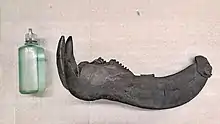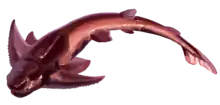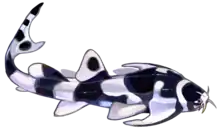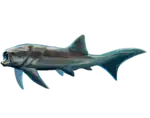| Gorgonichthys Temporal range: Late Devonian: Famennian, | |
|---|---|
 | |
| Reconstruction of Gorgonichthys clarki | |
| Scientific classification | |
| Domain: | Eukaryota |
| Kingdom: | Animalia |
| Phylum: | Chordata |
| Class: | †Placodermi |
| Order: | †Arthrodira |
| Suborder: | †Brachythoraci |
| Clade: | †Eubrachythoraci |
| Clade: | †Pachyosteomorphi |
| Clade: | †Aspinothoracidi |
| Genus: | †Gorgonichthys Claypole, 1892 |
| Species | |
| |


Gorgonichthys is extinct monospecific genus of large arthrodire placoderm. Fossils are found in the Upper Famennian Cleveland Shales of Late Devonian in Ohio. The type species is Gorgonichthys clarki.
Description
Gorgonichthys had sharp, pointed edges on the dental plates of the upper and lower jaws.[1] With a headshield length of up to 70 cm (28 in),[2] it is estimated to have been comparable to the size of Dunkleosteus.[3]
Phylogeny
Gorgonichthys is a member of the clade Aspinothoracidi, which belongs to the clade Pachyosteomorphi, one of the two major clades within Eubrachythoraci. It is closely related to the family Selenosteidae, and could possibly be included in that family. The cladogram below shows the phylogeny of Gorgonichthys:[4]
| Eubrachythoraci |
| ||||||||||||||||||||||||||||||||||||||||||||||||||||||||||||||||||||||||||||||||||||||||||||||||||||||||||||||||||||||||||||||||||||||||||
According to a 2022 Jobbins et al. study, Gorgonichthys was found to be more related to Heintzichthys than Gymnotrachelus, potentially making Gorgonichthys a member of Selenosteidae.[5]
| |||||||||||||
References
- ↑ Charlie Underwood, Martha Richter, Zerina Johanson (2019). Evolution and Development of Fishes. Cambridge University Press. p. 13. ISBN 9781107179448. Retrieved 1 September 2022.
{{cite book}}: CS1 maint: multiple names: authors list (link) - ↑ John A. Long. "A new dinichthyid fish (Placodermi: Arthrodira) from the Upper Devonian of Western Australia, with a discussion of dinichthyid interrelationships". Rea. West. Aust. Mus. 1987, p. 537.
- ↑ Joseph S. Nelson, Terry C. Grande, Mark V. H. Wilson (2016). Fishes of the World. Wiley. p. 40. ISBN 9781119220817. Retrieved 1 September 2022.
{{cite book}}: CS1 maint: multiple names: authors list (link) - ↑ Zhu, You-An; Zhu, Min; Wang, Jun-Qing (1 April 2016). "Redescription of Yinostius major (Arthrodira: Heterostiidae) from the Lower Devonian of China, and the interrelationships of Brachythoraci". Zoological Journal of the Linnean Society. 176 (4): 806–834. doi:10.1111/zoj.12356. ISSN 0024-4082.
- ↑ Jobbins, Melina; Rücklin, Martin; Ferrón, Humberto G.; Klug, Christian (2022). "A new selenosteid placoderm from the Late Devonian of the eastern Anti-Atlas (Morocco) with preserved body outline and its ecomorphology". Frontiers in Ecology and Evolution. 10. doi:10.3389/fevo.2022.969158. ISSN 2296-701X.







